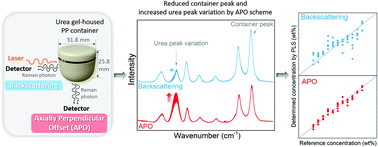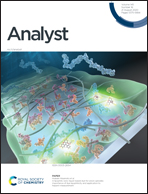Influence of interfering co-appearing container peaks on the accuracy of direct quantitative Raman measurement of a sample in a plastic container
Abstract
The axially perpendicular offset (APO) scheme was previously demonstrated as a versatile scheme able to minimize or eliminate the glass background in the direct and non-sampling Raman measurement of an ethanol sample housed in a glass bottle. Alternatively, when directly analyzing a sample housed in a plastic container, another typical container yielding strong Raman peaks itself, the Raman peaks of both the container and the housed sample are unavoidably present together in a collected spectrum. Therefore, a crucial issue to investigate under this situation is how the magnitude of the co-appearing container peaks influences the accuracy for quantitative analysis of the housed sample. For the evaluation, a non-sampling Raman spectroscopic measurement of the urea concentration in a urea gel housed in a circular polypropylene (PP) container was attempted by employing two axially perpendicular offset (APO) schemes with detection windows of different sizes (25.4 and 10.0 mm, referred to as the wide-window APO (WW-APO) and narrow-window APO (NW-APO), respectively), and transmission and back-scattering schemes incorporating a 25.4 mm detection window. The intensity ratios between the container and urea peaks in the collected spectra were different depending on the adopted measurement scheme. The intensity ratio was greatest (smallest container peak) in the NW-APO measurement due to the narrowed detection window, making the generated container Raman photons at the side-wall less detectable to the bottom-positioned detector. A spectral acquisition scheme allowing the maximal suppression of the container peaks, while still maintaining the sample features, was a key requirement to secure an accurate measurement of the sample concentration. In addition, a Monte Carlo simulation was used to visualize the distributions of the container and urea photons inside the sample-housed container.



 Please wait while we load your content...
Please wait while we load your content...